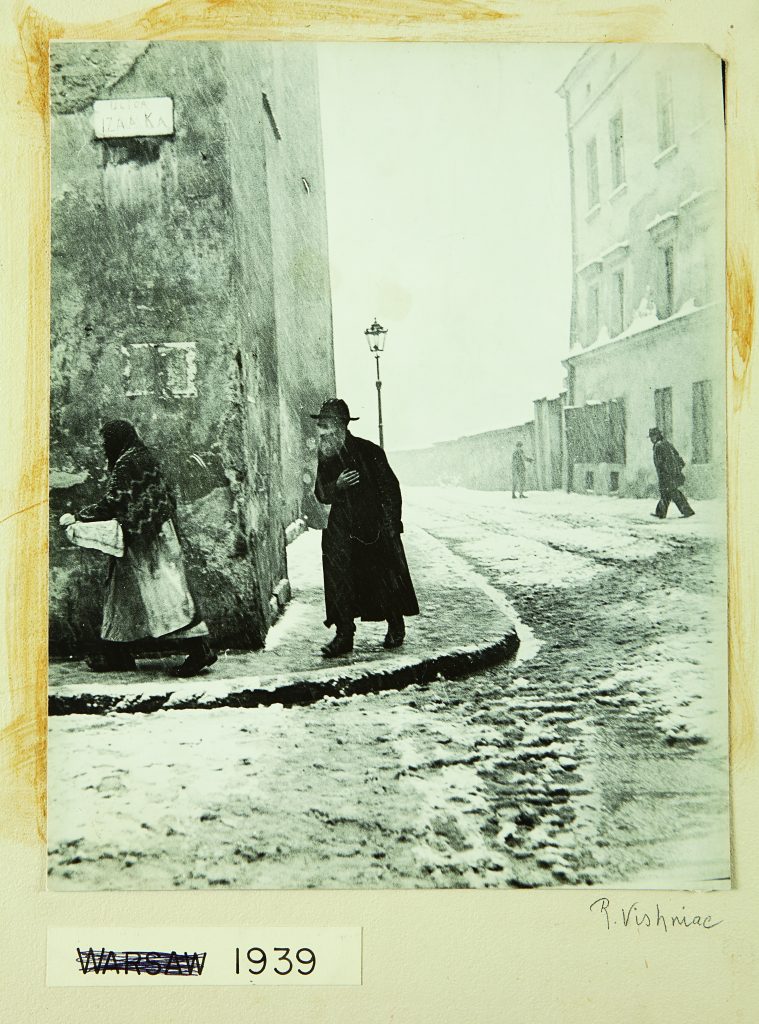Roman Vishniac (1897-1990)
Isaac street, Krakow, 1938
Gelatin silver print
Courtesy of the Leonid and Tatiana Nevzlin Collection
Roman Vishniac was a Russian-American photographer best known for his dramatic photographs of poor and pious Jews in the cities and shtetls of Central and Eastern Europe.
After being commissioned by the world’s largest Jewish relief organization, he spent four years faithfully documenting the members of communities that were subsequently exterminated in the Holocaust.
Must Know
Roman Vishniac (American/Russian, 1897–1990) was an important photographer and photojournalist. Born to a successful Jewish family in Pavlovsk, Russia, Vishniac moved to Berlin in 1920 where, as a self-taught photographer, he documented his surroundings. His work captured not only everyday Jewish urban and countryside life, but also functioned as a harrowing depiction of the rise of Nazism and the oppression of Jews prior to the outbreak of World War II. he received a commission in 1935 from the American Jewish Joint Distribution Committee to photograph poor Jewish communities in Eastern Europe, and would travel back and forth in disguise as a fabric salesman to avoid suspicion, developing film himself in his Berlin apartment. he carried a suitcase loaded with stockings and second- hand clothing; underneath, he hid a movie camera, a Rolleiflex for outdoor pictures and a Leica for indoor shots. he always used available light to preserve reality and to avoid detection. ”There was an opening on one side of my salesman’s case,” he says. ”I would place it in front of the subject and take my pictures with a cable release.
Vishniac’s photographs from the 1930s are all of a very distinct style; they are all focused on achieving the same end: capturing the unique culture of Jewish ghettos in Eastern Europe, especially the religious and impoverished.[2] His published pictures largely center on these people, usually in small groups, going about their daily lives: very often studying (generally religious texts), walking (many times through harsh weather), and sometimes just sitting; staring. They are “somber with poverty and with the gray light of European Winter”. On IZAAKA street in the historic Kazimierz district of Krakow was the Isaac Synagogue.
The Orthodox Izaak Synagogue (Synagoga Izaaka), built in 1644 was named for its donor, Izaak Jakubowicz (d. 1673), also called Isaac the Rich, a banker to King Ladislaus IV of Poland.
The founding legend of the synagogue was first told by the early 19th-century Polish rebbe, Simcha Bunim of Peshischa. It went as follows: “Ayzik Jakubowicz, a pious but poor Jew, dreamed that there was treasure hidden under the old bridge in Prague. Without delay, he made his way there. On arrival, it turned out the bridge was guarded by a squad of soldiers and that digging was out of the question. Ayzik told the officer about his dream, promising him half of the booty. The officer retorted, “Only fools like Polish Jews can possibly believe in dreams. For several nights now I have been dreaming that in the Jewish town of Kazimierz there is hidden treasure in the oven of the home of the poor Jew Ayzik Jakubowicz. Do you think I am so stupid as to go all the way to Cracow and look for the house of this Isaac the son of Jacob?”. Ayzik returned home immediately, took the oven apart, found the treasure and became rich. After this it was said: ‘There are some things which you can look for the world over, only to find them in your own home. Before you realise this, however, you very often have to go on along journey and search far and wide.
.”

